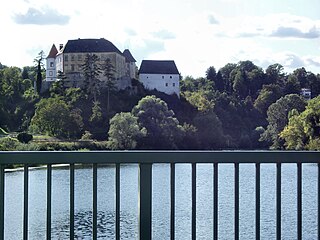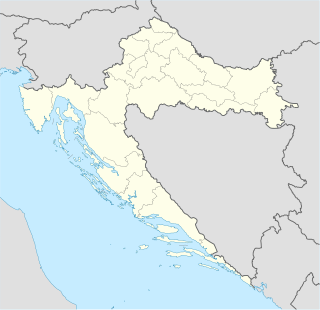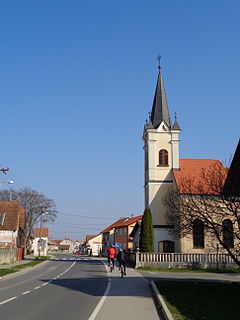
The Frankopan family, was a Croatian noble family, whose members were among the great landowner magnates and high officers of the Croatia in personal union with Hungary.

Karlovac is a city and municipality in central Croatia. According to the National census held in 2011 population of the settlement of Karlovac was 55,705.

Ogulin is a town in north-western Croatia, in Karlovac County. It has a population of 8,216 (2011), and a total municipal population of 13,915 (2011). Ogulin is known for its historic stone castle, known as Kula, and the nearby mountain of Klek.

The Crnković family are a Croatian noble family with its roots in the district of Gorski kotar.

Plaški is a village and a municipality in Karlovac County, Croatia. It is part of Lika.

Ozalj is a town in central Croatia, located north of Karlovac and southwest of Jastrebarsko, on the Kupa River. It is close to Žumberak in the north and the border with Slovenia in the northwest, with Metlika being the closest Slovenian town.

The fortress of Cetin is situated 5 kilometres (3 mi) south of Cetingrad above the village of Podcetin, in Croatia. The date when Cetin was founded is unknown. There are some indications that a settlement existed there in the times of the Roman Empire. The Parish of All Saints, in which the fortress is situated, was first mentioned in 1334. In 1387, king Sigismund, Holy Roman Emperor gifted Cetin to Ivan Krčki. Thereby it became the property of the Frankopan family.

Vuk II Krsto Frankopan Tržački was a Croatian nobleman and soldier of the Frankopan family, father of noted poet and politician Fran Krsto Frankopan. He was born about 1588.

Hercegovac is a village and a municipality in Bjelovar-Bilogora County, Croatia. In 2001 there were 2,791 inhabitants, of which 87% were Croats.

Bosiljevo is a village and municipality in Karlovac County, Croatia. It is located in the Gorski kotar region, on the highways A1 and A6 leading to Zagreb, Rijeka and Split.

Nikola Šubić Zrinski Square is a square and park in Donji Grad, the central part of Zagreb, the capital of Croatia. It is located near the central Ban Jelačić Square, halfway towards the Main Railway Station. It is a part of the Green horseshoe or Lenuci's horseshoe, which consists of seven squares in Donji grad. It is spread over an area of 12,540 square meters (135,000 sq ft).

Pribislavec is a village and a municipality in Međimurje County, in northern Croatia. It is located just outside Čakovec, the seat and largest city of Međimurje County, with its westernmost part basically connected with the city's easternmost part.

Turanj is a suburb of the city of Karlovac, Croatia. It is located in the south of the city, separated from the rest by the rivers Mrežnica and Korana. The D1 highway passes through Turanj. It is not registered as a standalone settlement in the Croatian census of 2001.

The Tržan Castle is a ruined medieval castle above the village of Modruš in the northern part of historical Lika region, central Croatia. Before the administrative seat of the former Modruš County, it is today just a ruin in the Josipdol Municipality in the southern part of the Karlovac County.

Georg von Khevenhüller was a Carinthian nobleman of the Khevenhüller dynasty. Though a dedicated Protestant by faith, he served as a governor of the Catholic House of Habsburg for several decades. He is also famous for building the city-fortress of Karlovac in Croatia.

Blagaj is a medieval ruined castle located on the right bank of the Korana river in modern Karlovac county, Croatia. Around it formed an eponymous village, Blagaj. It has a rectangular floorplan, and was once one of the larger castles in the region, with a central tower, similar to Belaj, Karlovac county. The old parish church of Sv. Duh is proposed to have been situated not far from the ruins, where there are today two churches next to each other.


























